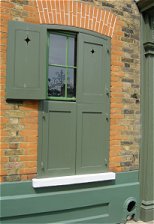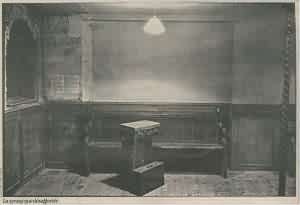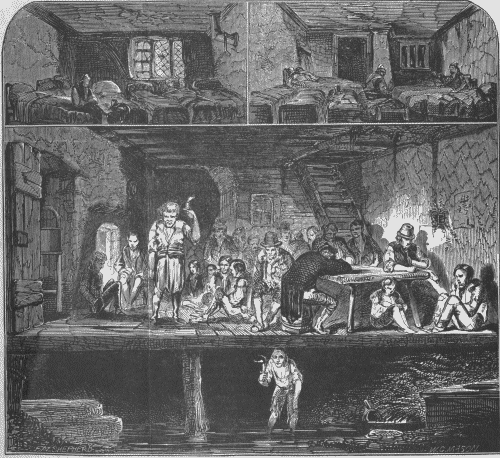
|
|
Margaret
Cox
Life and Death in Spitalfields
1700-1850
Council for British Archaeology
1996
A fascinating and gruesome account
of the removal and analysis of the bodies from the crypt of Christ Church
Spitalfields, one of the key sites in Peter Ackroyd's Hawksmoor.
Science, archaeology and sociology then combine to investigate the lives,
diseases and deaths of the people that the bodies once were. A horrible
job, with danger from old diseases - smallpox in particular, and an unsurprisingly
high level of sick-leave amongst 'members of the project who found dealing
with human remains, some with surviving soft tissue, some which appeared
almost complete, and some putrescent, distressing." The results give fascinating
insights into many aspects of the lives of old Londoners. Like the fact
that the late 17th / Early 18th Centuries saw the
coldest temperatures since the Ice Age, resulting in the famous Frost
Fairs on the Thames, and that increased mortality rates, famine, epidemics
and migrations at the time can all be put down to this Little Ice Age.
And that the illicit trade in corpses for Anatomy Schools lead to much
increased security in coffin construction and that a 'mort-safe' was sometimes
used to temporarily protect coffins for a few weeks, that is until 'autolysis,
putrefaction, and insect activity' made the corpse drastically less saleable
and the coffin could be removed.
|
|
Rachel Lichtenstein and
Iain Sinclair
Rodinsky's room Granta 1999
In 1969 David Rodinsky left his attic room above the synagogue at 19 Princelet Street,
Spitalfields, and never returned. He left
behind a room full of papers and books and the trappings of his life, which
remained undisturbed, gathering dust and damp and fascination, until it
was opened in 1980. An impression of his head remained on his pillow, and
piles of papers, books, LPs, pieces of paper and chocolate wrappers contained
odd notes and scribblings in many of the obscure languages Rodinsky spent
his time learning. He was, in short, one of those odd unkempt men who study
and write endlessly, often impenetrably, on reams of paper in strange
hand-writing
in public libraries all over London. But Rodinsky has the advantage
of the post-mortem patronage of artists, and the Spitalfields factor. Rachel
Lichtenstein stumbled on Rodinsky on a visit to the Princelet Street
synagogue,
and became obsessed with the mystery and how his family's history shared
common ground with her own. It's easy to see the fascination of this life
mysteriously left in abeyance, and the appeal of sifting through boxes
of resonant detritus. But to allow your interest free rein you must quell
your doubts: doubts about whether the story would've got the same exposure
had Rodinsky's home been in, say, Stamford Hill; doubts about how the whole
thing plays up to the romantic needs of the rich residents of the new Spitalfields
who have bought into a history of the lives of generations of poor immigrants
whose successive colonisations of the area they have put a stop to, with
their inflated house prices, ever-present builder's skips, and minimal
bars with short names. Sinclair's awareness, and discussion, of this phenomenon,
and his part in it, only comes across as a desire for both cake and the
eating of it. |
|

There is also a facsimile of Rodinsky's copy of the A to
Z of London called Dark Lanthorns Goldmark
1999, in which Iain Sinclair follows the routes
Rodinsky had marked in biro. It comes complete with a facsimile Cadbury's
Whole Nut wrapper bookmark.
Then there's a lovely little booklet of Lichtenstein's
walk Rodinsky's Whitechapel Artangel
1999, which is a good introduction to whole
thing, and full of photos of fascinating little scraps and scenes of long-lost
Jewish Whitechapel. Mighty interesting stuff, then, combining the fascination
of the history of real people, out of control mythologising, and the dubieties
of the present, and well worth quelling many doubts for. Try to visit the
Synagogue too - it's a visit you'll not soon forget.
|
Sarah Wise
The Blackest Streets The Life and Death of a Victorian Slum
This is a book about the Nichol, a Victorian
slum whose notoriety was still unabated locally a hundred years later. I
was raised in Shoreditch, a few streets north of the area it used to
occupy, and it remained a famously 'rough' area, it's squalid history
leaching into the 1970s and infecting the rebuilt streets of the Boundary
Estate. This book provides an account of just how bad it was and gives
some convincing reasons for it remaining such an undealt-with a blot on
the local landscape for much of the nineteenth century. In a nutshell -
well-meaning laws and pious benefactors were powerless against the vested
interests of the slumlords who owned the properties and ran the local
vestry, which was the equivalent of the local council today. The
criminality of the locals gets a good few pages too, with the
reminiscences of a crim called Arthur Harding, published locally in the
1970s, providing much material to shake your head at. (Another account of
life in the Nichol is to be found in Arthur Morrison's famous novel A
Child of the Jago.) It's a book which will provoke a lot of head
shaking, not least at how the same arguments that prevented progress and
lead to such suffering then are still being trotted out. If you lived
through the Thatcher years you'll find the 1880s excuses for doing nothing
- helping the poor will just make them feckless and jobless, the market
must be allowed to make everything right, property-owning is the pinnacle
of human achievement - very familiar. And still today the bleating about
the encroachments of the 'Nanny State' found in newspapers like The
Daily Mail encourages inaction and inequality. But the Nichol was such
a jerry-built rookery of squalor and criminality it had to go, eventually.
Demolition began in 1891 of the 730 dwellings that held 5,719 people. The
rubble from the slums was used to raise a mound which was topped by a
bandstand and still stands in the middle of the Boundary Estate, which was
opened in 1900. The old tenants were priced out of the new homes by rents
of 3s and moved on to cause overcrowding elsewhere, and more prosperous
professionals moved in. Today it all seems very arty and middle-class,
with a website, podcasts, art installations and the same infestation of
trendy types that's ponced up my old neighbourhood further north. Renting
a flat in the Grade II listed estate now will set you back £350 a month.
Anyway, the book - a warmly recommended read that puts humanity into
history. |
|
 |





